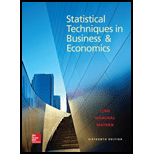
Concept explainers
a.
Develop a simple price index using 2000 as the base period.
a.
Answer to Problem 8E
The simple price index using 2000 as the base period is given below:
| Item | Price ($) (2000) | Price ($) (2014) | Simple Price Index |
| Syringes (dozen) | 6.10 | 6.83 | 111.97 |
| Thermometers | 8.10 | 9.35 | 115.43 |
| Advil (bottle) | 4 | 4.62 | 115.5 |
| Patient record forms (box) | 6 | 6.85 | 114.17 |
| Computer paper (box) | 12 | 13.65 | 113.75 |
Explanation of Solution
Calculation:
The simple price index using 2000 as the base period is obtained as follows:
| Item | Price ($) (2000) | Price ($) (2014) | |
| Syringes (dozen) | 6.10 | 6.83 | |
| Thermometers | 8.10 | 9.35 | |
| Advil (bottle) | 4 | 4.62 | |
| Patient record forms (box) | 6 | 6.85 | |
| Computer paper (box) | 12 | 13.65 |
b.
Develop a simple aggregate price index using 2000 as the base period.
b.
Answer to Problem 8E
The simple aggregate price index using 2000 as the base period is 114.09.
Explanation of Solution
Calculation:
The simple aggregate price index using 2000 as the base period is obtained as follows:
Thus, the simple aggregate price index using 2000 as the base period is 114.09.
c.
Find Laspeyres’ price index using 2000 as the base period.
c.
Answer to Problem 8E
Laspeyres’ price index using 2000 as the base period is 113.03.
Explanation of Solution
Calculation:
Laspeyres’ price index using 2000 as the base period is obtained as follows:
Thus, Laspeyres’ price index using 2000 as the base period is 113.02.
d.
Find Paasche’s index using 2000 as the base period.
d.
Answer to Problem 8E
Paasche’s index using 2000 as the base period is 112.83.
Explanation of Solution
Calculation:
Paasche’s index using 2000 as the base period is obtained as follows:
Thus, Paasche’s index using 2000 as the base period is 112.83.
e.
Find Fisher’s ideal index.
e.
Answer to Problem 8E
Fisher’s ideal index is 112.93.
Explanation of Solution
Calculation:
Fisher’s ideal index is obtained as follows:
Thus, Fisher’s ideal index is 112.93.
Want to see more full solutions like this?
Chapter 17 Solutions
Statistical Techniques in Business and Economics
- (c) Utilize Fubini's Theorem to demonstrate that E(X)= = (1- F(x))dx.arrow_forward(c) Describe the positive and negative parts of a random variable. How is the integral defined for a general random variable using these components?arrow_forward26. (a) Provide an example where X, X but E(X,) does not converge to E(X).arrow_forward
- (b) Demonstrate that if X and Y are independent, then it follows that E(XY) E(X)E(Y);arrow_forward(d) Under what conditions do we say that a random variable X is integrable, specifically when (i) X is a non-negative random variable and (ii) when X is a general random variable?arrow_forward29. State the Borel-Cantelli Lemmas without proof. What is the primary distinction between Lemma 1 and Lemma 2?arrow_forward
 MATLAB: An Introduction with ApplicationsStatisticsISBN:9781119256830Author:Amos GilatPublisher:John Wiley & Sons Inc
MATLAB: An Introduction with ApplicationsStatisticsISBN:9781119256830Author:Amos GilatPublisher:John Wiley & Sons Inc Probability and Statistics for Engineering and th...StatisticsISBN:9781305251809Author:Jay L. DevorePublisher:Cengage Learning
Probability and Statistics for Engineering and th...StatisticsISBN:9781305251809Author:Jay L. DevorePublisher:Cengage Learning Statistics for The Behavioral Sciences (MindTap C...StatisticsISBN:9781305504912Author:Frederick J Gravetter, Larry B. WallnauPublisher:Cengage Learning
Statistics for The Behavioral Sciences (MindTap C...StatisticsISBN:9781305504912Author:Frederick J Gravetter, Larry B. WallnauPublisher:Cengage Learning Elementary Statistics: Picturing the World (7th E...StatisticsISBN:9780134683416Author:Ron Larson, Betsy FarberPublisher:PEARSON
Elementary Statistics: Picturing the World (7th E...StatisticsISBN:9780134683416Author:Ron Larson, Betsy FarberPublisher:PEARSON The Basic Practice of StatisticsStatisticsISBN:9781319042578Author:David S. Moore, William I. Notz, Michael A. FlignerPublisher:W. H. Freeman
The Basic Practice of StatisticsStatisticsISBN:9781319042578Author:David S. Moore, William I. Notz, Michael A. FlignerPublisher:W. H. Freeman Introduction to the Practice of StatisticsStatisticsISBN:9781319013387Author:David S. Moore, George P. McCabe, Bruce A. CraigPublisher:W. H. Freeman
Introduction to the Practice of StatisticsStatisticsISBN:9781319013387Author:David S. Moore, George P. McCabe, Bruce A. CraigPublisher:W. H. Freeman





